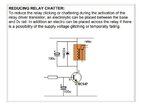gary36
Full Member level 4
I have simple relay driver shown in the figure below. 24V and 5V are isolated. Relay coil current is around 24mA. When I power on, relay chatters heavily even through IN is connected to ground. What could be the problem?. I simulated this circuit and it worked fine.


